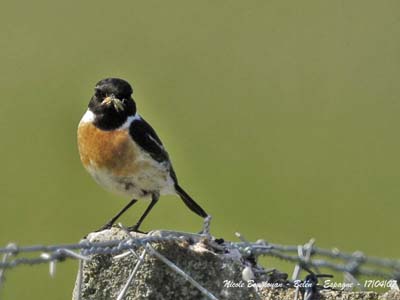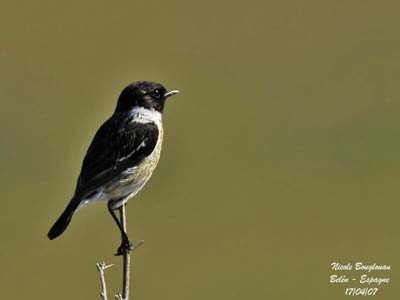
European Stonechat
Saxicola rubicola
Passeriforme Order – Muscicapidae Family
BIOMETRICS:
Length: 12-13 cm
Weight: 13-17 g
DESCRIPTION:
This small passerine was formerly member of Family Turdidae. It belongs now to the Muscicapidae, which includes the Old World Flycatchers.
Adult male in breeding plumage has black upperparts with edged brown feathers on mantel. Rump and uppertail coverts are white streaked dark. Wings show narrow white wing patch. Neck and breast sides are white.
On the underparts, breast is orange-rufous, extending down to the flanks while becoming paler. Belly and undertail coverts are creamy-white.
The head show black hood extending down to the middle of the nape, as in chin and throat.
Bill, eyes, legs and feet are black.
PROTECTION / THREATS / STATUS:
European Stonechat is fairly common in its range, but declines occurred in some parts, due to changes in the habitat for agriculture and pastures.
Conservation in Europe depends on measures to preserve the habitat such as retaining scattered trees, bushes and hedges in the fields.
In Africa, this species has benefited from forest clearance, as in other countries. Not globally threatened at this moment.
Fr: Tarier pâtre
All : Schwarzkehlchen-rubicola
Esp : Tarabilla común
Ital: Saltimpalo comune
Nd: Roodborsttapuit
Russe: Черноголовый чекан
Sd: Svarthakad buskskvätta
Photographers:
Aurélien Audevard
OUESSANT DIGISCOPING
Callie de Wet
Flickr Galleries
Nicole Bouglouan
PHOTOGRAPHIC RAMBLE
Text by Nicole Bouglouan
Sources:
HANDBOOK OF THE BIRDS OF THE WORLD Vol 10 by Josep del Hoyo-Andrew Elliott-David Christie - Lynx Edicions - ISBN: 8487334725
THE COMPLETE BOOK OF BRITISH BIRDS – Written by “Royal Society for the Protection of Birds” experts - Préface de Magnus Magnusson - Michael Cady- Rob Hume Editors - ISBN: 0749509112
THE HANDBOOK OF BIRD IDENTIFICATION FOR EUROPE AND THE WESTERN PALEARCTIC by Mark Beaman, Steve Madge - C.Helm - ISBN: 0713639601
L’ENCYCLOPEDIE MONDIALE DES OISEAUX - Dr Christopher M. Perrins - BORDAS - ISBN: 2040185607
Wikipedia (Wikipedia, The Free Encyclopedia)

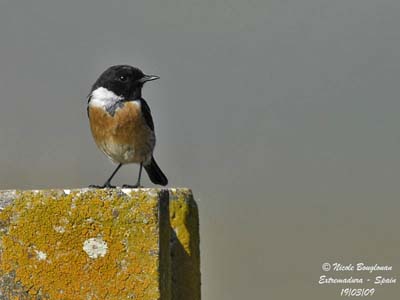
Female is duller and browner instead black, with buffy edges above. The wing patch is smaller. Rump is rufous streaked dark brown.
Underparts are dull orange-rufous, slightly brighter on the breast.
On the head, the hood is dark brown on the crown. We can see a buff supercilium. Neck sides are buffy-white. Face is brownish.
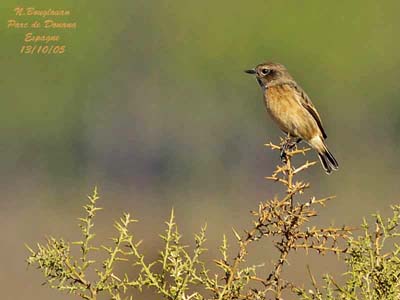
Juvenile resembles female with dark brown streaked pale buff upperparts and buff rump. Wings show a small white wing patch.
Underparts are pale buff. Breast and flanks ate streaked brown.
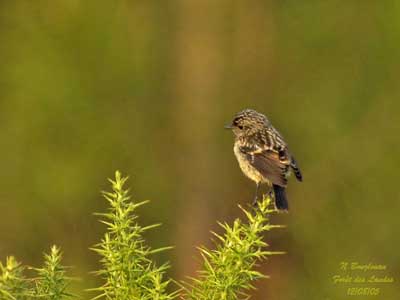
In fresh plumage, male is browner above with narrow white collar.
Underparts are almost entirely orange-rufous, but paler.
Female shows buff edges above and the throat is paler.
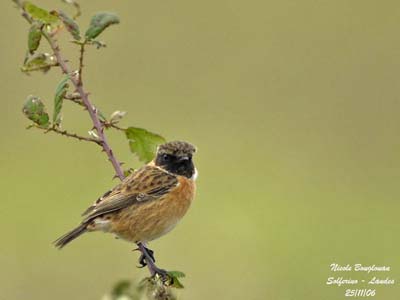
We find numerous subspecies sharing the wide range.
However, among these different races, five species are now mentioned as full species.
Saxicola rubicola is the race described above. It is found in W, C and S Europe, NW Africa, Turkey E to W Caucasus area. Non-breedign areas are in North Africa and Middle-East.
Saxicola torquatus or AFrican Stonechat is found in South Africa.
Male has black upperparts, a broad wing patch and more white on neck sides, and white rump. Breast and flanks are chestnut-rufous, belly and undertail coverts are white. Hood is black.
Female is browner with buffy edges on mantel feathers. Rump is white and the wing patch is smaller. Underparts are orange-rufous, paler on belly. Undertail coverts are white. The hood is brown streaked black, becoming paler on cheeks, chin and throat. (Below)
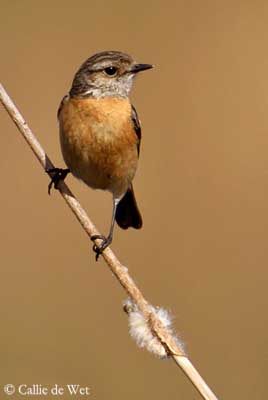

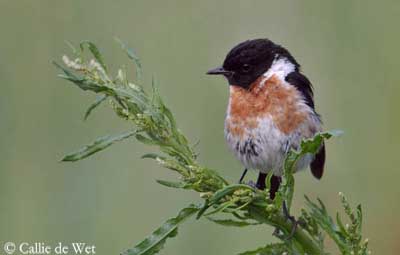
Saxicola maurus or Siberian Stonechat is found in E Finland, N and E European Russia E to Mongolia, E Tien Shan and Pakistan. Non-breeding areas are in SW and S Asia.
This bird has white rump and more white on neck sides. The wing patch is medium-sized compared with both previous. Breast is orange-rufous, more intense on breast centre.
Female is similar but much duller. (Below)

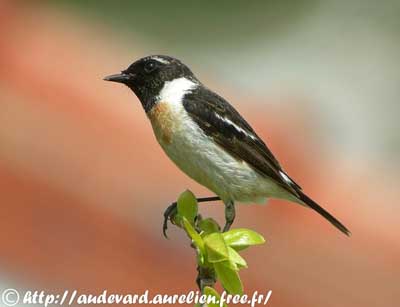
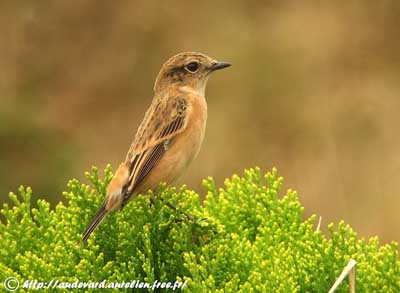
WINTER
2d year
Saxicola albofiasciatus or Ethiopian Stonechat, is found in SE Sudan,
Ethiopian Highlands and NE Uganda.
Male is black and white, without any rufous or chestnut. The wing patch is small.
Female resembles “rubicola” with paler head an dbelly.
Saxicola tectes or Reunion Stonechat is endemic to Reunion Island.
It has white supercilium, making it different from other species, as chin and throat of which the white joins the neck sides.
Female is paler overall than others, with tinged rufous breast.
VOICE: SOUNDS BY XENO-CANTO
European Stonechat’s typical calls include a strident “chak” as advertising call, a clear “wheet” as alarm call. Both may be combined “wheet-chak-chak” in greater alarm. During interactions between males, we can hear a brief hoarse “krrrr”, and “chee-chee” in higher aggression. In courtship, the male utters a long “whiiiii” and the begging female a quiet “sisisisisi”.
The song is more varied during the short flights.
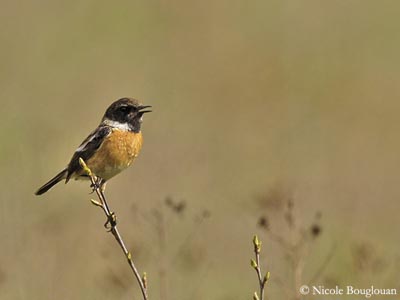
HABITAT:
European Stonechat frequents a variety of open, arid areas. In Europe, it may be found in open scrubby country with bushes and shrubs, and stone walls, fences and wires within or adjacent to flat area of varied types such as heathland, dry plains, grassy hillsides, woodland edges, wide shrubby riverbeds, marshy areas, roadsides.
This species occurs from sea-level up to 500 metres of elevation, sometimes 800 metres and up to 1800 metres in Italian Alps.
The race “maurus” prefers wet grassy meadows, shrubby marshes and dry woodlands on hillsides up to 3000/4000 metres of elevation.
RANGE:
See above and by species.
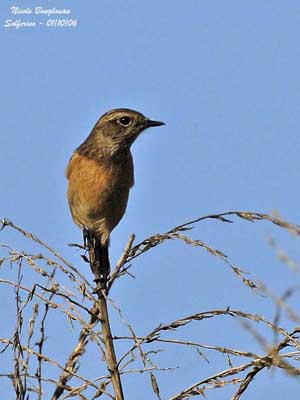
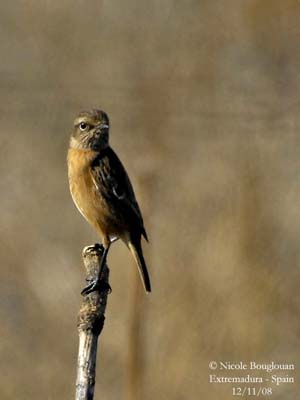
BEHAVIOUR:
The European Stonechat feeds almost entirely on invertebrates such as small to medium-sized insects and larvae. It often hunts from low exposed perch, using the typical “perch-and-pounce” method. It flies down to catch the prey on the ground and returns to the perch, often the same. It also performs sallies and may pursue flying insects over some distance in fluttering flight, or hovers to glean preys from vegetation.
The method may change according to the season.
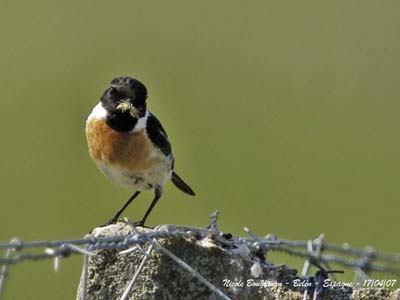
European Stonechat is commonly territorial all year round when sedentary in its range, and proclamation of breeding areas is made by song. The male sings from a perch in upright posture in order to display its bright coloured breast.
This species is mainly monogamous and each pair builds the nest on the ground or very close.
Usually in these species, the male guards the female. It is often perched above her or follows her wherever she goes. This strategy is called “mate-guarding”. It guards her against other males to avoid the loss of paternity.
Male performs a characteristic song flight in which it displays the white prominent patches of wings and rump. It appears to dance in the sky after launching into the air from gorse.
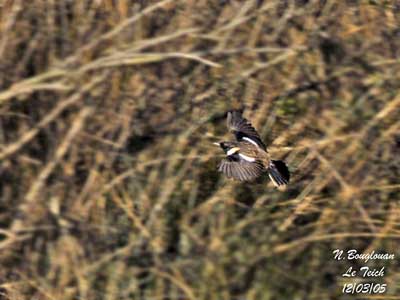
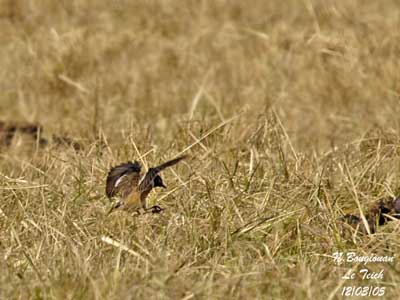
European Stonechat may be sedentary, altitudinal or partial migrant or migrant. Usually, the northernmostbirds move southwards in winter.
FLIGHT:
European Stonechat may perform hovering, fluttering flight for feeding. The flight display is like a dance in the air, used to expose the white patch of the plumage.
REPRODUCTION:
Breeding season varies according to the range.
The nest is a deep cup, a loose structure made with grass, leaves, rootlets and stems. The interior is lined with finer materials such as small rootlets, hair, wool and feathers. It is placed on the ground or very close, hidden at base of tussock or under small bush, sometimes in hole in earth bank or under stone, depending on the region.
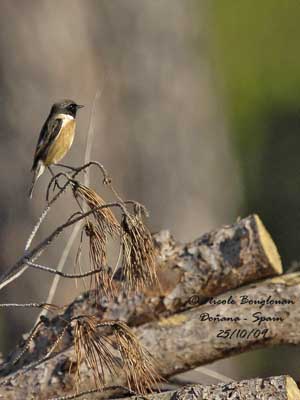
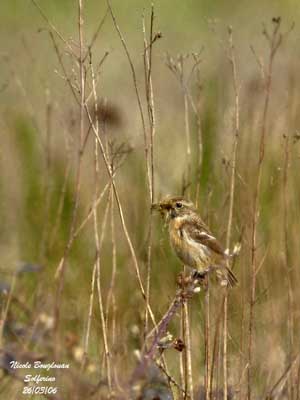
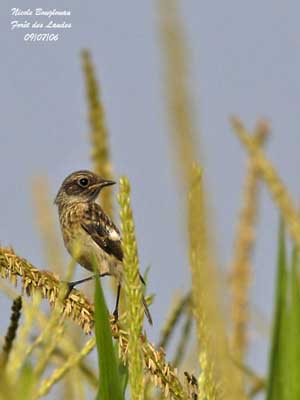
Female lays 4-6 bluish-green eggs, spotted reddish-brown. Incubation lasts about two weeks.
Chicks have spotted plumage when fledging, about 13-16 days later. They depend on parents for food during some days or week according to the range.
In Palearctic, the nests are parasitized by Common Cuckoo.
DIET:
European Stonechat feeds manly on invertebrates such as insects and larvae of numerous species, beetles, flies, ants, grasshoppers, bugs, damselflies and spiders. It may also take snails, small earthworms and small fish and lizards.
It also consumes small vertebrates, seeds and fruits.
